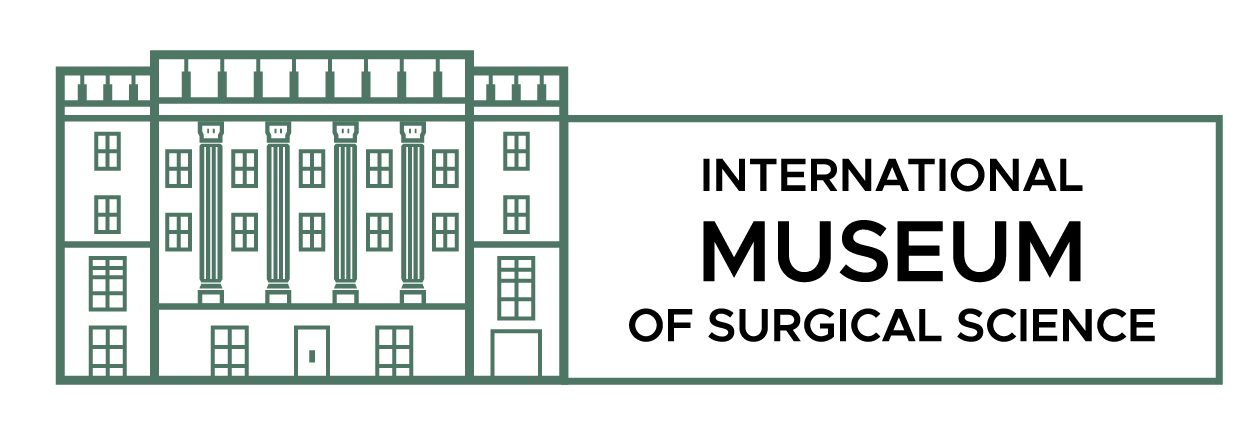Published by Lorca Jolene.
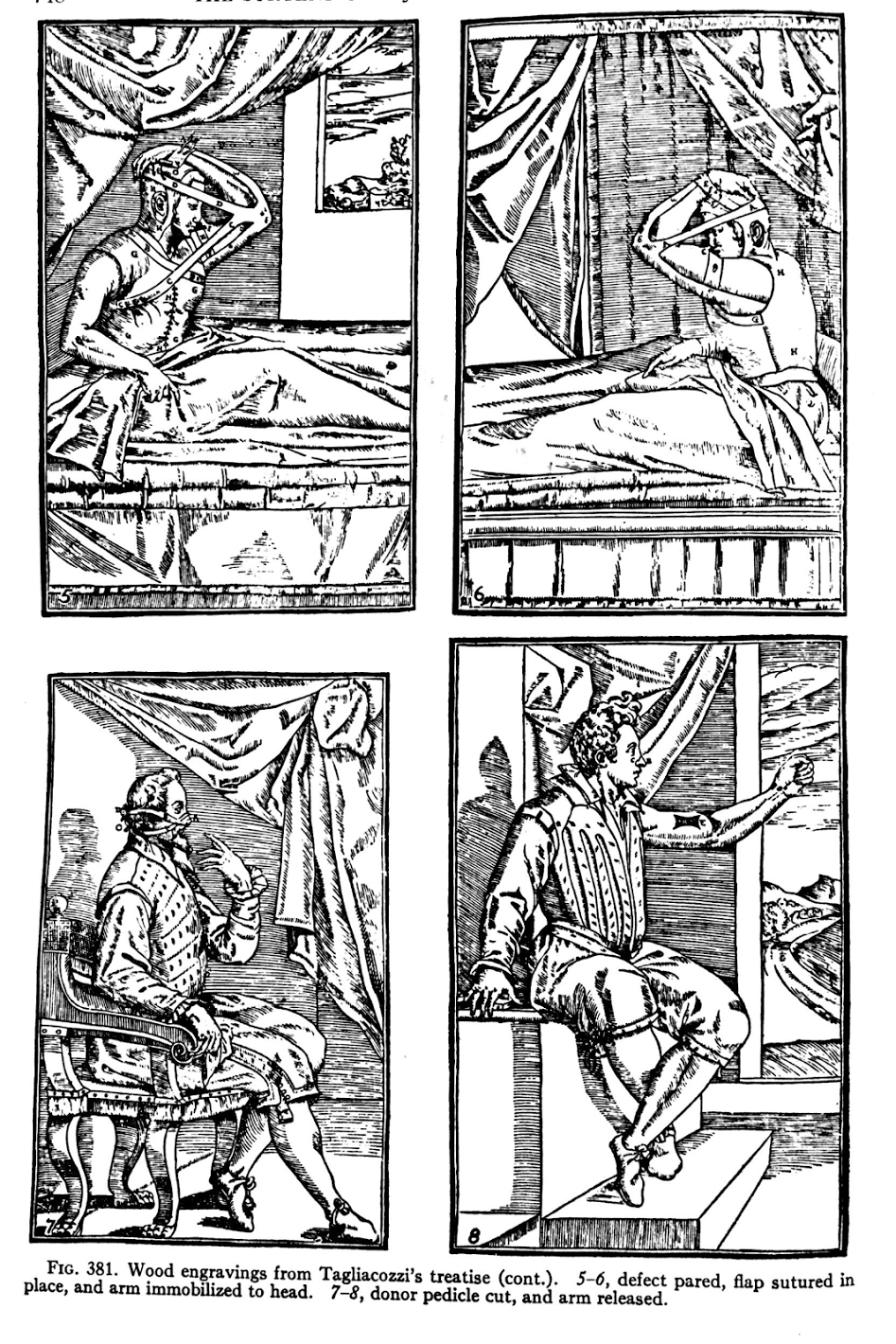
Wood engraving of Gasparo Tagliacozzi’s (1546-1599) method of using arm flaps in nasal reconstruction. This technique became known as the Italian method of rhinoplasty, and is still used today. From The Surgery of Injury and Plastic Repair (pg. 748).
Tremendous advances in facial reconstructive and plastic surgery occurred during the 1940s due to the sheer number of World War II soldiers who sought treatment for disfiguring injuries that they sustained in combat. At the beginning of the war, surgeons would have prepared for such cases by consulting texts like Samuel Fomon’s The Surgery of Injury and Plastic Repair (1939)—a copy of which is housed in the Thorek Manuscript and Rare Book Collection at the International Museum of Surgical Science. This book, published in 1939, is a detailed and beautifully illustrated record of the techniques used to reconstruct facial features from transplanted tissue at the beginning of WWII.

Figure depicting the restoration of a nasal defect by using a flap of skin and bone taken from the forearm. The patient would have to remain in this position for approximately nine days until bone and skin could be detached from the forearm and used to reconstruct the nose. From The Surgery of Injury and Plastic Repair (pg. 766).
As The Surgery of Injury and Plastic Repair explains, there are two primary ways of transplanting tissue, either using grafting or flaps. Grafting involves removing a mass of living tissue from one site of the body to be implanted on another. The drawback of this technique is that the transplanted tissue is detached from its original blood supply, and might not survive long enough to grow new vessels that connect to the new site’s blood supply. Flap surgery avoids this complication: a section of donor tissue remains attached to its original site, which ensures that the tissue is consistently nourished while it heals on the recipient site. The tissue is entirely detached from its original site when it has successfully connected to the recipient site’s blood supply (Fomon, 96). Using flaps increases the rate of successful transplants, although the procedure can require a patient to patiently remain for weeks with parts of their body connected by little tubes of flesh (Fomon, 766).
Even with the techniques outlined in texts like Fomon’s The Surgery of Injury and Plastic Repair, surgeons during WWII struggled to treat unprecedented numbers of patients with severe burns and disfigurements.
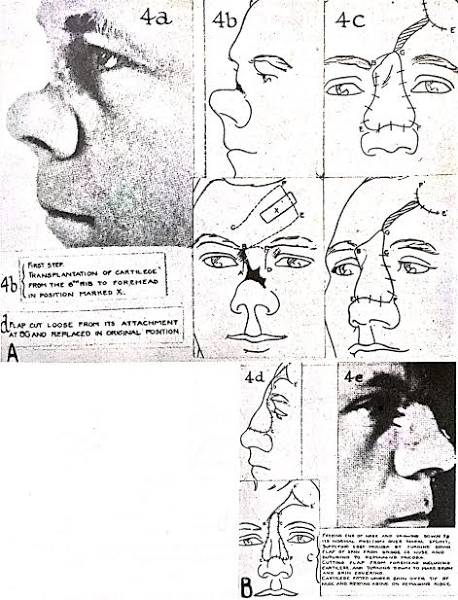
Figure depicting reconstruction of the nasal dorsum with a forehead flap. From The Surgery of Injury and Plastic Repair (pg. 809).
Sir Archibald McIndoe developed revolutionary techniques in burn care and reconstructive surgery while treating WWII soldiers at the Queen Victoria Hospital at East Grinstead, UK. He pushed flap surgery to a new level by walking tubes of skin end-over-end from large areas of uninjured skin, a process known as “waltzing.” His legacy as a surgeon goes beyond his skill with a scalpel. At a time when disfigured patients were isolated until their surgeries proved successful, McIndoe prioritized his patients’ dignity, need for camaraderie, and reintegration into society. Most of his patients were young, traumatized by the horrors of war, and devastated by their injuries. Many were suicidal when they arrived at the hospital. McIndoe encouraged his patients to befriend each other and hospital staff. He made free beer available to his patients while they coped with weeks of surgeries and soon his patients formed a drinking club. As the soldiers bonded over their common experiences, as survivors of a harrowing war and subjects of experimental surgical techniques, the drinking party reformed under a new name: the Guinea Pig Club (Fong, 2012 & East Grinstead Museum).
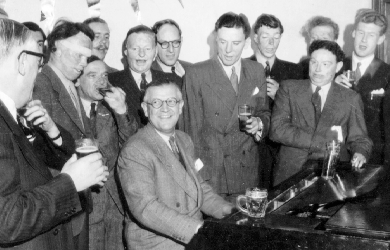
Sir Archibald McIndoe with Guinea Pig Club members. Image courtesy of the East Grinstead Museum.
McIndoe embraced the Guinea Pig Club and encouraged its members to pursue relationships and build skills both inside and outside the hospital. He took them to local bars and to tea at local families’ homes. If a play was opening or a movie premiering in town, he had them invited as honored guests. His patients could often be spotted strolling the streets outside the hospital with flaps dangling from their heads and limbs; East Grinstead became known as “the town that did not stare.” Bonding with their peers and being treated with respect by their physician and community helped many of his patients have fulfilling lives after the war (Fong, 2012 & East Grinstead Museum). One Guinea Pig Club member, Bill Foxley, endured 29 operations to reconstruct his face after attempting to save a wireless operator from a burning plane. He met his wife at the hospital where he was receiving treatment, and went on to have a career at the Central Electricity Generating Board. Another member, Saundy Saunders, suffered burns on 40 percent of his body when his plane crashed. His experience with facial reconstruction inspired him to become a doctor (Fong, 2012).
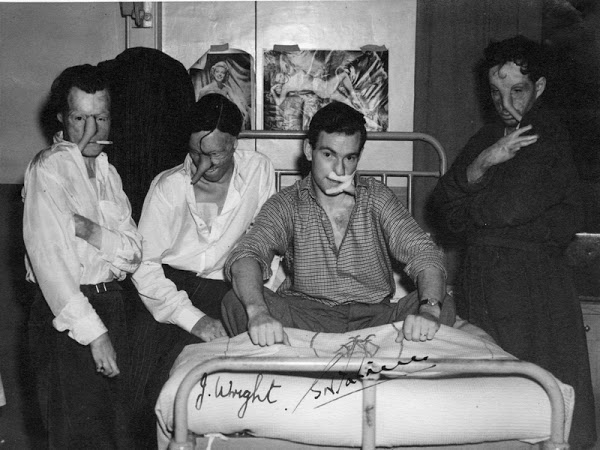
Guinea Pigs at the Queen Victoria Hospital, East Grinstead. Image courtesy of East Grinstead Museum.
By the end of WWII, the Guinea Pig Club had 649 members from Great Britain, Canada, Australia, New Zealand, and the Czech Republic. Their story stands as testament to how medical knowledge can advance when respect is mutual between patient and physician and when patients’ communities welcome them as valuable and viable in each stage in their recovery. The Guinea Pigs’ brotherhood and Sir McIndoe’s ingenuity and skill together promote a vision of surgery progressing hand-in-hand with social acceptance of those who struggle through pain and being different.
Sources:
Fomon, Samuel. The Surgery of Injury and Plastic Repair. Baltimore: The Williams & Wilkins Company, 1939. Print.
Fong, Kevin. Extreme Medicine: How Exploration Transformed Medicine in the Twentieth Century. New York: Penguin Press, 2012. Print.
“Rebuilding Bodies & Souls | Guinea Pig Club.” East Grinstead Museum, www.eastgrinsteadmuseum.org.uk/guinea-pig-club/. Accessed 25 September, 2017.
Lorca Jolene is an archival student interested in medical anthropology, and as a circus entertainer performs medical theater acts across Chicago. Lorca is also the current Collections Intern – Thorek Manuscripts and Rare Books Collection at the International Museum of Surgical Science.
